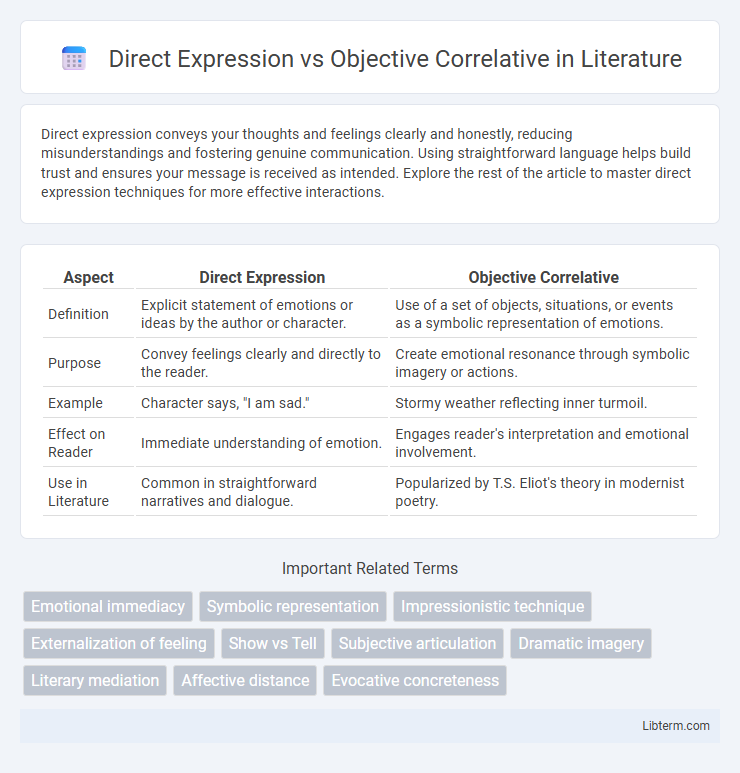Direct expression conveys your thoughts and feelings clearly and honestly, reducing misunderstandings and fostering genuine communication. Using straightforward language helps build trust and ensures your message is received as intended. Explore the rest of the article to master direct expression techniques for more effective interactions.
Table of Comparison
| Aspect | Direct Expression | Objective Correlative |
|---|---|---|
| Definition | Explicit statement of emotions or ideas by the author or character. | Use of a set of objects, situations, or events as a symbolic representation of emotions. |
| Purpose | Convey feelings clearly and directly to the reader. | Create emotional resonance through symbolic imagery or actions. |
| Example | Character says, "I am sad." | Stormy weather reflecting inner turmoil. |
| Effect on Reader | Immediate understanding of emotion. | Engages reader's interpretation and emotional involvement. |
| Use in Literature | Common in straightforward narratives and dialogue. | Popularized by T.S. Eliot's theory in modernist poetry. |
Introduction to Direct Expression and Objective Correlative
Direct Expression involves conveying emotions and thoughts explicitly through clear, straightforward language or dialogue, making the writer's feelings transparent to the audience. Objective Correlative, a term popularized by T.S. Eliot, relies on a set of objects, situations, or events that evoke a specific emotion indirectly, allowing readers to experience the sentiment through symbolic representation. This technique enhances literary depth by enabling readers to infer emotions through external details rather than overt statements.
Defining Direct Expression in Literature
Direct expression in literature refers to the straightforward communication of an author's thoughts, feelings, or themes without relying on symbolic or indirect means. This technique emphasizes clarity and emotional transparency, allowing readers to understand the author's intent explicitly through dialogue, narration, or description. Unlike objective correlative, which uses objects or situations to evoke emotions, direct expression openly conveys the inner experiences of characters or the narrative voice.
Understanding the Objective Correlative Concept
The concept of the objective correlative, introduced by T.S. Eliot, refers to a set of objects, situations, or events that evoke a specific emotion in the audience without explicitly stating it. This literary technique allows writers to convey complex feelings indirectly through symbolic imagery, enabling readers to experience emotions more vividly compared to direct expression. Understanding the objective correlative enhances appreciation of nuanced storytelling by recognizing how external elements represent internal states.
Historical Origins and Influences
The concept of Direct Expression stems from Romantic literature, where poets like Wordsworth emphasized personal emotions as the primary source of artistic authenticity. Objective Correlative, introduced by T.S. Eliot in the early 20th century, originates from modernist literary theory, proposing that emotions must be evoked through a set of objects or situations rather than direct narration. Historical influences on these concepts include Romanticism's emphasis on individual subjectivity and modernism's focus on symbolic representation and emotional detachment.
Key Differences Between Direct Expression and Objective Correlative
Direct expression involves explicitly stating emotions or thoughts through clear, straightforward language, allowing readers direct access to a character's feelings. Objective correlative conveys emotions indirectly by presenting a set of objects, situations, or events that evoke the intended emotional response without overt explanation. The key difference lies in direct expression's transparent emotional communication versus objective correlative's symbolic, associative approach that relies on external elements to suggest inner states.
Famous Literary Examples of Direct Expression
Direct expression in literature involves characters or narrators explicitly stating emotions, as seen in Shakespeare's "Romeo and Juliet," where Juliet declares, "My bounty is as boundless as the sea." This technique contrasts with the objective correlative, used by T.S. Eliot in "The Love Song of J. Alfred Prufrock," where external objects evoke internal feelings indirectly. Direct expression often provides immediate emotional clarity, making famous lines memorable and impactful in conveying character intent.
Notable Uses of Objective Correlative in Literature
Objective correlative, a literary technique popularized by T.S. Eliot, uses a set of objects, situations, or events to evoke specific emotions indirectly, creating a symbolic resonance that replaces direct expression. In literature, notable uses include Shakespeare's *Macbeth*, where the bloody dagger symbolizes Macbeth's guilt and ambition, and Eliot's own *The Waste Land*, which employs fragmented imagery to convey post-war disillusionment. Modernist writers like James Joyce and Virginia Woolf also utilized objective correlatives to deepen psychological complexity and evoke moods without overt explanation.
Advantages and Limitations of Each Technique
Direct expression allows clear communication of emotions and thoughts, fostering immediate understanding and personal connection. Its limitation lies in potential over-simplicity, which may reduce artistic subtlety and reader engagement. Objective correlative uses symbols or situations to evoke emotions indirectly, enhancing depth and interpretive richness, but it may confuse readers unfamiliar with the symbolic context or require more effort to decipher.
Impact on Reader Engagement and Interpretation
Direct expression offers clear, straightforward communication, enabling readers to grasp emotions and themes immediately, which enhances engagement through clarity. Objective correlative uses symbolic objects or situations to evoke emotions indirectly, encouraging readers to interpret deeper meanings and engage actively with the text. This approach fosters a more personalized and immersive experience, as readers connect the symbols with their own emotions and context.
Conclusion: Choosing the Right Technique for Effective Storytelling
Direct expression allows writers to convey emotions and thoughts explicitly, ensuring clarity and immediate reader connection. Objective correlative relies on symbolic imagery and objects to evoke emotions indirectly, enriching narrative depth and subtlety. Selecting the appropriate technique depends on the story's tone and purpose, balancing straightforward communication with layered symbolism for impactful storytelling.
Direct Expression Infographic

 libterm.com
libterm.com